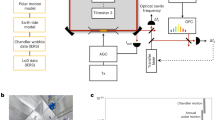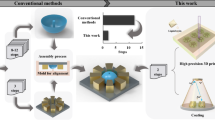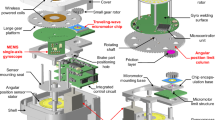Abstract
Optical gyroscopes are among the most accurate rotation measuring devices and are widely used for navigation and accurate pointing. Since the advent of photonic integrated components for communications, and with their increasing complexity, there has been interest in the possibility of chip-scale optical gyroscopes1. Besides the potential benefits of integration, such solid-state systems would be robust and resistant to shock. Here, we report a gyroscope using Brillouin ring lasers on a silicon chip. Its stability and sensitivity enable measurement of Earth’s rotation, representing a major milestone for this new class of gyroscope.
This is a preview of subscription content, access via your institution
Access options
Access Nature and 54 other Nature Portfolio journals
Get Nature+, our best-value online-access subscription
27,99 € / 30 days
cancel any time
Subscribe to this journal
Receive 12 print issues and online access
209,00 € per year
only 17,42 € per issue
Buy this article
- Purchase on SpringerLink
- Instant access to full article PDF
Prices may be subject to local taxes which are calculated during checkout



Similar content being viewed by others
Data availability
The data that support the plots within this paper and other findings of this study are available from the corresponding author upon reasonable request.
Code availability
The code that supports the plots within this paper and other findings of this study is available from the corresponding author upon reasonable request.
Change history
25 March 2020
A Correction to this paper has been published: https://doi.org/10.1038/s41566-020-0622-0
References
Dell’Olio, F., Tatoli, T., Ciminelli, C. & Armenise, M. Recent advances in miniaturized optical gyroscopes. J. Eur. Opt. Soc. 9, 14013 (2014).
Sagnac, G. L’éther lumineux démontré par l’effet du vent relatif d’éther dans un interféromètre en rotation uniforme. C. R. Acad. Sci. 95, 708–710 (1913).
Post, E. J. Sagnac effect. Rev. Mod. Phys. 39, 475–493 (1967).
Lefèvre, H. C.The Fiber-Optic Gyroscope 2nd edn (Artech House, 2014).
Chow, W. W. et al. The ring laser gyro. Rev. Mod. Phys. 57, 61–104 (1985).
Armenise, M. N., Ciminelli, C., Dell’Olio, F. & Passaro, V. M. N. Advances in Gyroscope Technologies (Springer, 2010).
Liu, K. et al. The development of micro-gyroscope technology. J. Micromech. Microeng. 19, 113001 (2009).
Lee, H., Chen, T., Li, J., Painter, O. & Vahala, K. J. Ultra-low-loss optical delay line on a silicon chip. Nat. Commun. 3, 867 (2012).
Bauters, J. F. et al. Planar waveguides with less than 0.1 dB/m propagation loss fabricated with wafer bonding. Opt. Express 19, 24090–24101 (2011).
Lee, H. et al. Chemically etched ultrahigh-Q wedge-resonator on a silicon chip. Nat. Photon. 6, 369–373 (2012).
Spencer, D. T., Bauters, J. F., Heck, M. J. R. & Bowers, J. E. Integrated waveguide coupled Si3N4 resonators in the ultrahigh-Q regime. Optica 1, 153–157 (2014).
Li, J., Suh, M. G. & Vahala, K. J. Microresonator Brillouin gyroscope. Optica 4, 346–348 (2017).
Gundavarapu, S. et al. Sub-hertz fundamental linewidth photonic integrated Brillouin laser. Nat. Photon. 13, 60–67 (2019).
Gundavarapu, S. et al. Interferometric optical gyroscope based on an integrated Si3N4 low-loss waveguide coil. J. Light. Technol. 36, 1185–1191 (2018).
Liang, W. et al. Resonant microphotonic gyroscope. Optica 4, 114–117 (2017).
Zhang, J., Ma, H., Li, H. & Jin, Z. Single-polarization fiber-pigtailed high-finesse silica waveguide ring resonator for a resonant micro-optic gyroscope. Opt. Lett. 42, 3658–3661 (2017).
Khial, P. P., White, A. D. & Hajimiri, A. Nanophotonic optical gyroscope with reciprocal sensitivity enhancement. Nat. Photon. 12, 671–675 (2018).
Maayani, S. et al. Flying couplers above spinning resonators generate irreversible refraction. Nature 558, 569–572 (2018).
Zarinetchi, F., Smith, S. P. & Ezekiel, S. Stimulated Brillouin fiber-optic laser gyroscope. Opt. Lett. 16, 229–231 (1991).
Kadiwar, R. K. & Giles, I. P. Optical fibre Brillouin ring laser gyroscope. Electron. Lett. 25, 1729–1731 (1989).
Li, J., Lee, H., Chen, T. & Vahala, K. J. Characterization of a high coherence, Brillouin microcavity laser on silicon. Opt. Express 20, 20170–20180 (2012).
Black, E. D. An introduction to Pound–Drever–Hall laser frequency stabilization. Am. J. Phys. 69, 79–87 (2001).
Yang, K. Y. et al. Bridging ultrahigh-Q devices and photonic circuits. Nat. Photon. 12, 297–302 (2018).
Lai, Y.-H., Lu, Y.-K., Suh, M.-G., Yuan, Z. & Vahala, K. Observation of the exceptional-point-enhanced Sagnac effect. Nature 576, 65–69 (2019).
Matsko, A. B., Liang, W., Savchenkov, A. A., Ilchenko, V. S. & Maleki, L. Fundamental limitations of sensitivity of whispering gallery mode gyroscopes. Phys. Lett. A 382, 2289–2295 (2018).
Cai, M., Painter, O. & Vahala, K. J. Observation of critical coupling in a fiber taper to a silica-microsphere whispering-gallery mode system. Phys. Rev. Lett. 85, 74–77 (2000).
Spillane, S. M., Kippenberg, T. J., Painter, O. J. & Vahala, K. J. Ideality in a fiber-taper-coupled microresonator system for application to cavity quantum electrodynamics. Phys. Rev. Lett. 91, 043902 (2003).
Acknowledgements
We thank the Defense Advanced Research Projects Agency (DARPA) for financial support (N66001-16-1-4046) and A. Chern, C.-L. Liu, L. Peng and X. Yi at Caltech for helpful discussions. We also gratefully acknowledge the critical support and infrastructure provided for this work by The Kavli Nanoscience Institute at Caltech.
Author information
Authors and Affiliations
Contributions
Y.-H.L., M.-G.S., J.L. and K.V. conceived the offset-counter-pumped SBL gyroscope for the Earth rotation measurement; M.-G.S. fabricated the microresonator devices; Y.-H.L. and M.-G.S. conducted the measurement, with assistance from J.L., Y.-K.L., B.S., Q.-F.Y., S.H.L. and K.Y.Y.; Y.-H.L., M.-G.S. and K.V. analysed the data; Y.-H.L., Y.-K.L. and K.V. derived the theory; H.W. provided the Kerr linewidth analysis; Y.-H.L., M.-G.S. and K.V. contributed to writing the manuscript; K.V. supervised the project.
Corresponding author
Ethics declarations
Competing interests
The authors declare no competing interests.
Additional information
Publisher’s note Springer Nature remains neutral with regard to jurisdictional claims in published maps and institutional affiliations.
Extended data
Extended Data Fig. 1 Packaged gyroscope.
Photograph of a 36mm-diameter silica resonator ring laser gyroscope packaged in a brass module with a thermoelectric cooler and fiber connectors.
Extended Data Fig. 2 System diagram of Earth rotation measurement.
See text for operational description. EDFA: erbium-doped fiber amplifier, AOM: acoustic-optical modulator, PM: phase modulator, PD: photo-detector, FC: frequency counter, TM: temperature monitor, PI: proportional-integral servo, ESA: electrical spectrum analyzer, RF: radio frequency, TEC: thermal electric cooler, f1 (f2): modulation frequency of AOM1 (AOM2), fPDH: modulation frequency of the phase modulator for Pound-Drever-Hall locking loop. The ESA is used for beat signal characterization on the photodetectors and is disconnected during the Earth rotation measurement.
Supplementary information
Rights and permissions
About this article
Cite this article
Lai, YH., Suh, MG., Lu, YK. et al. Earth rotation measured by a chip-scale ring laser gyroscope. Nat. Photonics 14, 345–349 (2020). https://doi.org/10.1038/s41566-020-0588-y
Received:
Accepted:
Published:
Issue Date:
DOI: https://doi.org/10.1038/s41566-020-0588-y
This article is cited by
-
Navigation-grade interferometric air-core antiresonant fibre optic gyroscope with enhanced thermal stability
Nature Communications (2025)
-
Nonreciprocal spontaneous parametric process
Light: Science & Applications (2025)
-
Cross-polarized stimulated Brillouin scattering-empowered photonics
Nature Photonics (2025)
-
A terahertz-bandwidth non-magnetic isolator
Nature Photonics (2025)
-
Integrated microcavity electric field sensors using Pound-Drever-Hall detection
Nature Communications (2024)



